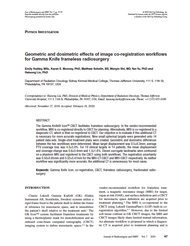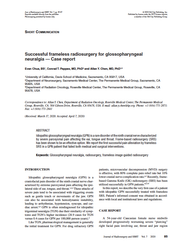- Home
- Journal Contents Downloads
- JRSBRT Downloads
- JRSBRT 7.1, p. 67-75
Product Description
Determining normal tissue dose in intracranial stereotactic radiosurgery: A diameter-based predictive nomogram
Donal Cummins, Siobhra O’Sullivan, Mary Dunne, Ronan McDermott, Maeve Keys, David Fitzpatrick, Clare Faul, Mohsen Javadpour and Christina Skourou
Purpose: A major factor in dose-fractionation selection for intracranial metastases in stereotactic radiosurgery (SRS) is the size of the target lesion and consequently the dose-volume to the surrounding normal brain tissue (NTV), as this has been correlated with brain radiation necrosis (RN). This study outlines the development and validation of a predictive model that can estimate the NTV for a range of dose-fractionation schemes based on target diameter from a patient’s MRI.
Methods: Data from a cohort of historical SRS clinical treatment plans were used to extract three key input parameters for the model – conformity index, gradient index, and a scaling factor – which were then defined as a function of target volume. The relationship between the measured tumour diameter and the NTV was established by approximating the target to a spherical volume covered by the prescription dose. A scaling factor (λNTV) describes the non-linear fall-off of dose beyond the target. This was then used to provide a first-order approximation of the resulting NTV. The predictive model was retrospectively validated using linear regression against actual NTV values from 39 historical SRS plans which were independent to the derivation process. The model was validated for both three-dimensional (3D) target diameter and axial-only two-dimensional (2D) estimates of target diameter values.
Results: The prediction model directly relates lesion diameter to NTV volume (cc) and thus RN risk for a given dose-fractionation. The predicted NTV (cc) for both 3D- and 2D-based volume estimates could statistically significantly predict the actual NTV (cc): R2=0.942 (p<.0005) for 3D-based estimate, and R2=0.911 (p=<.0005) for axial-only 2D-based estimate.
Conclusion: This knowledge-based method for NTV prediction in intracranial SRS provides the clinician with a decision support tool to appropriately select dose-fractionation prior to treatment planning.
Keywords: SRS, normal tissue, prediction, nomogram, radiation necrosis, brain
After payment has been processed for your order of a digital copy (PDF) of this article, you will see a download link on your completed order page and also receive an email containing a download link. The links, which will enable you to download one copy of the article, will expire after 24 hours.
 Loading... Please wait...
Loading... Please wait...








